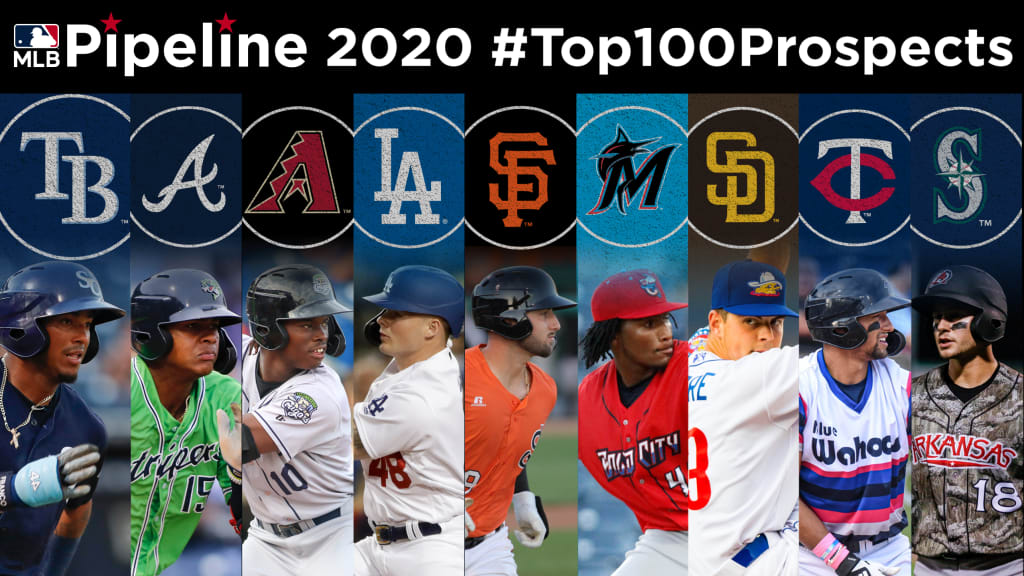
The release of MLB Pipeline’s Top 100 Prospects list for 2020 caps a two-week stretch during which we looked at the Top 10 prospects at each position. We’ll continue to break down our new Top 100 in different ways in the coming days, beginning with a look at which teams are best represented on the list.
Nine different teams placed at least five players in this year’s Top 100, marking the fourth time in the past nine years -- MLB Pipeline expanded its list from 50 to 100 prospects in 2012 -- that that has occurred. It last happened in 2017, one year after there were an MLB Pipeline-record 11 clubs with at least five Top 100 prospects.
While nine clubs account for nearly half (46, to be exact) of the entire 2020 Top 100 this year, the Tampa Bay Rays, with their six Top 100 prospects, are the best-represented team this year, ending the San Diego Padres’ two-year reign.
Tampa Bay Rays
The Rays have placed six players in the Top 100 three different times since 2012, including twice in the past three years, and they’ve now had at least three representatives make the list in each of the last nine years.
Tampa Bay’s latest crop of top-prospect talent is headlined by 18-year-old shortstop Wander Franco, MLB Pipeline’s youngest-ever No. 1 overall prospect. He’s one of three Rays to rank inside the Top 50, left-hander Brendan McKay (No. 15) and middle infielder Vidal Brujan (No. 47). Xavier Edwards (No. 72), whom the Rays acquired from San Diego during the offseason, is the next highest-ranked Rays prospect on the Top 100, while right-handers Shane Baz and Brent Honeywell (Nos. 90 and 91, respectively) round out the last of their six representatives.
Yet, based on Prospect Points (PP) -- No. 1 ranking equated to 100 Prospect Points, a No. 2 ranking to 99 and so on down to the No. 100 ranking amounting to one -- the Rays rank fifth among all 30 teams with 292. That total is down from the previous two years (‘19: 286; ’18: 345), though it’s still well above Tampa Bay’s 2012-19 average (245 PP).
San Diego Padres
The Padres, actually, lead all 30 clubs in Prospect Points for a third straight year, with their five Top 100 prospects rankings totaling up to 341 PP. They set a new MLB Pipeline record last year in both representation (10 Top 100 prospects) and PP (574) after claiming the top spot in both categories in 2018 (7, 423).
MacKenzie Gore (No. 4), MLB Pipeline’s top-ranked pitching prospect, and Luis Patino (No. 27) are the only holdovers from last year’s record-setting Padres group, and they’re joined by a pair of newcomers in CJ Abrams (No. 25) and Luis Campusano (No. 50) as well as 2019 Trade Deadline acquisition Taylor Trammell (No. 57). And even though all five of the Padres’ Top 100 prospects rank inside the top 60 spots, it’s still MLB Pipeline’s lowest top PP total since 2012.
Atlanta Braves
One of eight teams with five prospects on the 2020 Top 100, the Braves have at least five players ranked in the Top 100 for a fifth straight year. They also rank third in Prospect Points (307) this year on the strength of their Top 100 prospects trio of Cristian Pache (No. 13), Drew Waters (26) and Ian Anderson (37).
Best of the rest
The Dodgers are fourth in PP (296), with No. 2 overall prospect Gavin Lux headlining their five Top 100 Prospects, while the Mariners (282) rank seventh on the strength of their outfield duo of Jarred Kelenic and Julio Rodriguez, both of whom rank inside the top 20.
Miami (224 PP), San Francisco (221) and Arizona’s (166 PP) farm systems were among the most-improved in 2019, and that notion is reflected in their five Top 100 representatives apiece. The Twins (214) have the fewest Prospect Points among teams with at least five Top 100 prospects, though they do house the No. 8 overall prospect in Royce Lewis, the No. 1 overall pick in the 2017 Draft.
All four White Sox prospects in this year’s Top 100 rank inside the Top 50, and three of them -- Luis Robert (No. 3), Andrew Vaughn (16) and Michael Kopech (20) -- made the Top 25. As a result, the South Siders check in this year with the second-most Prospect Points (325), albeit their lowest total since 2016.
Three of the Tigers’ (296 PP) Top 50 prospects are former first-round picks (Casey Mize, Matt Manning and Riley Greene), and the other (Tarik Skubal) was one of last season’s biggest breakout prospects.
Historical context
In terms of the all-time standings, the Rays (67), Dodgers (62), Braves (61) and Padres (55) have produced the most top prospects since the inception of MLB.com's rankings in 2004. On the other end of the spectrum are the Giants (30), Angels (31), Tigers (32), Nationals (32), Cardinals (33) and Orioles (33).
Since those rankings were expanded in 2012, the Padres (5.33), Braves (5.00), Pirates (4.56), Rays (4.56) and Twins (4.44) have averaged the most Top 100 prospects per year. Dating back to 2004, the Rays (3.94), Dodgers (3.65) and Braves (3.59) stand out for their Top 100 success.
Nine teams have two or fewer prospects on the 2020 Top 100. The Astros, Rockies and Red Sox all have a single representative, while the Brewers are the lone team without a Top 100 prospect.
